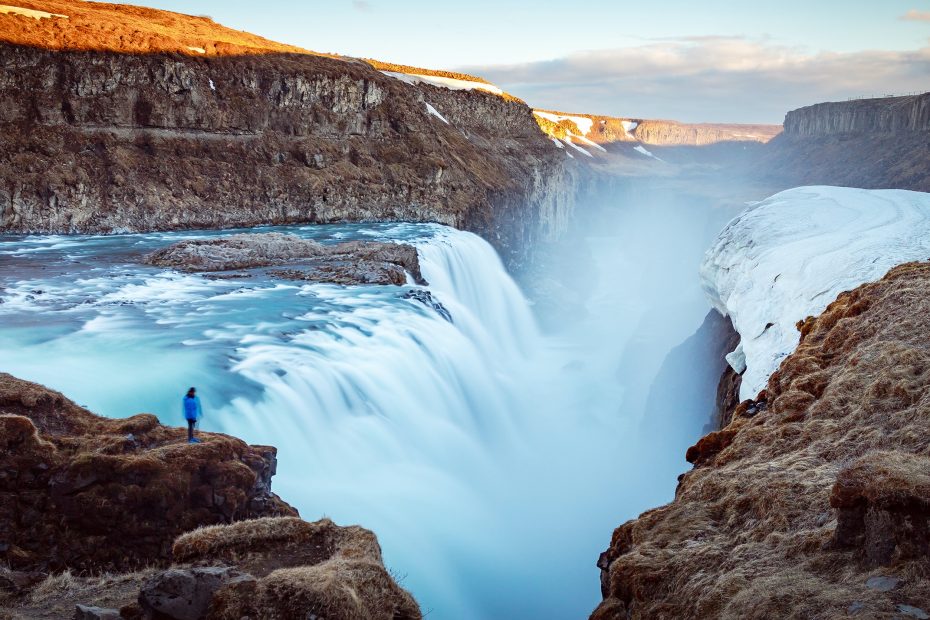From massive glaciers to explosive geysers to fiery volcanoes, Iceland offers some of the most stunning natural wonders and landscapes in the world. This Nordic island is a paradise for outdoor adventurers, with countless opportunities to explore otherworldly terrain. Join me on a journey through Iceland’s most magnificent natural phenomena.
Table of Contents
Marveling at Icelandic Glaciers
Sprawling ice sheets and glacier tongues cover over 10% of Iceland. The largest glacier, Vatnajökull, blankets around 8% of the country. This enormous icecap holds the distinction of being the largest glacier in Europe. Adventurous travelers can join guided glacier hikes and ice climbs on outlet glaciers like Sólheimajökull and Skaftafellsjökull. Strapping on crampons and roaming the icy landscape provides an unforgettable experience. The brilliant blue crevasses and ice caves will take your breath away. Just remember to dress warmly for the freezing conditions!
Witnessing the Erupting Strokkur Geyser
Iceland contains some of the most spectacular and active geothermal areas on the planet. The beloved Geysir hot spring area offers a front row seat to the mesmerizing eruptions of Strokkur geyser. This reliable geyser shoots a tower of scalding water over 130 feet (40 meters) into the air every 5-10 minutes. Standing nearby as Strokkur violently erupts definitely gets the heart pumping! For your safety, follow warning signs and keep your distance from the boiling water.
Hiking Volcanic Mountains
Iceland is home to some of the most iconic volcanoes in the world. The stunning Snæfellsjökull volcano covered in ice and the notorious Eyjafjallajökull volcano that erupted in 2010 are just two examples. Journey to the top of a majestic volcano by joining guided hiking tours up mountaintop volcanoes like Mt. Hekla. Experience volcanic terrain up-close while admiring sensational views from the summit. Check weather forecasts and volcanic activity reports before your volcano hike.
Chasing More Natural Wonders
In addition to glaciers, geysers, and volcanoes, Iceland abounds with other incredible natural sights. Thundering waterfalls like Gullfoss, Skógafoss, and Seljalandsfoss will make your jaw drop. Black sand beaches like Reynisfjara offer the unique chance to lounge on volcanic sand. And don’t forget the famous Blue Lagoon – this geothermal spa with naturally heated blue waters is the ultimate way to relax after adventures.
Planning Your Iceland Adventure
The best time to visit Iceland is during the summer months of June through August when the weather is mildest. However, winter adventures to see the Northern Lights also have their appeal. Iceland is very accessible, and tour buses make getting around easy. Be sure to pack plenty of warm and waterproof clothing as well as hiking boots and gear like walking poles.
With its endless natural wonders and breathtaking landscapes, Iceland promises an unforgettable outdoor adventure. Exploring glaciers, geysers, volcanoes, and more will leave you in awe. So start planning your trip to experience Iceland’s magnificent scenery and phenomena for yourself!
Conclusion
From massive Vatnajökull glacier to the erupting Strokkur geyser to the volcanic rubble beaches, Iceland’s otherworldly landscape beckons adventurers. Glacier hiking brings you face to face with brilliant blue ice caves under ancient ice sheets. Witnessing the explosive eruptions of geysers and hiking the slopes of Eyjafjallajökull volcano provide once-in-a-lifetime thrills. Chasing thundering waterfalls and relaxing in the Blue Lagoon’s geothermal waters rounds out this Nordic island’s wealth of natural wonders. With so many incredible phenomena and landscapes, Iceland is truly a dream destination for explorers and nature lovers. Start planning your own Icelandic adventure soon!
FAQs
1. What is the best time of year to visit Iceland?
The summer months of June through August are the best time to visit Iceland. The weather is mildest and daylight hours are longest during the summer, providing the best conditions for exploring Iceland’s natural wonders.
2. How can I get around to see all of Iceland’s natural wonders?
Joining guided tour buses and groups is the easiest way to get around Iceland and see key sights. You can also rent a car and self-drive, or use shuttles between key destinations. The main Ring Road highway loops the island.
3. What essential gear and clothing should I pack for exploring Iceland’s glaciers, geysers, and volcanoes?
Pack waterproof and windproof outer layers, tall insulated boots, warm hats and gloves, sunglasses and sunscreen, and hiking poles. Bring robust crampons and ice axes if glacier hiking. Always check forecasted weather and dress accordingly.
4. Is it safe to hike on glaciers and volcanoes in Iceland?
Yes, it is safe when you take guided tours and follow safety precautions. Guides assess conditions daily and lead hikes safely. Pay attention to warning signs, stay on marked trails, and don’t venture into closed areas. Check weather forecasts and volcanic activity reports.
5. What are the top 5 natural wonders and landscapes to see in Iceland?
The Blue Lagoon, Gullfoss waterfall, Vatnajökull glacier, the erupting geysers at Geysir, and Snæfellsjökull volcanic national park are 5 of the most stunning natural phenomena and landscapes to experience.
